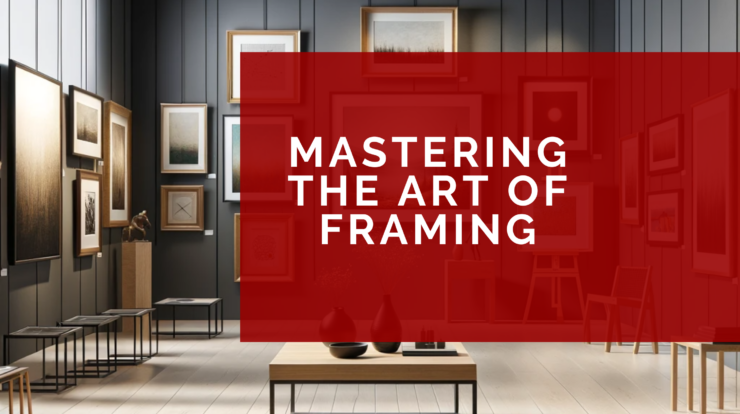
As a gallery owner, I’ve witnessed firsthand the transformative power of framing on artwork. Over the years, I’ve gleaned a wealth of knowledge about the impact of framing on both the presentation and sale of art. I’d like to share some thoughts on framing that can serve as the beginning of an ongoing conversation around framing and presentation.
Investing in Quality Framing
Quality framing is more than just an aesthetic choice; it’s an investment in your art’s future. A well-chosen frame enhances not only the artwork’s appearance but also its perceived value. It’s about finding that sweet spot where the frame complements without overpowering the piece. Remember, the frame is the suit or dress your artwork wears to its own premiere.
Balancing Budget and Aesthetics
Navigating budget constraints while maintaining an appealing aesthetic can be challenging. However, it’s essential to strike a balance that doesn’t compromise the artwork’s integrity. An artist must be judicious in choosing frames that augment the art without causing financial strain.
Gallery Wraps: A Contemporary Alternative

For those working within tighter budgets, gallery wraps offer a modern, cost-effective alternative to traditional frames. This option works wonderfully for certain art styles, providing a sleek and contemporary look that resonates with many collectors.
Consistency is Key
Adopting a consistent framing style has multiple benefits. It not only simplifies the framing process but also establishes a cohesive and professional appearance for your body of work. Consistency in framing can become part of your signature as an artist.

Smart Frame Management
Efficient frame management involves strategic repurposing. Having a stock of frames to rotate between artworks can be a game-changer. This approach not only reduces costs but also allows for flexibility in presentation and storage.
Frame Cost-Value Alignment
From a gallery owner’s perspective, I recommend that the cost of framing should ideally be around 10-15% of the retail value of the artwork. If this cost-value ratio is skewed, it’s worth considering either finding more cost-effective framing solutions or elevating the value of your art. This might involve targeting higher-end galleries or shows that can support the value your art deserves.
Just-In-Time Framing
The just-in-time framing strategy is about being prepared but not over-committed. Having a few samples of your work, framed and ready for display, allows potential buyers to visualize the finished product. Additional pieces can be framed as needed, reducing upfront costs and storage challenges.
Framing: The Final Touch in Art’s Journey
Framing is an integral part of the art presentation and sales process. It requires careful consideration, strategic planning, and a keen eye for aesthetics. By effectively managing framing choices, artists can significantly enhance the appeal and marketability of their work, creating lasting impressions in the minds of collectors and gallery visitors alike.
What aspects do you find most crucial in the framing process? How do you navigate the investment involved in framing, ensuring it enhances the value of your artwork without breaking the bank? And what are your go-to tactics for keeping costs under control while still achieving that perfect presentation? Your insights and stories are not just valuable to me but to our entire artistic community. Share your thoughts and let’s continue this enlightening conversation about the art and science of framing.
As a new gallery owner I see paintings in all kinds of “finished formats”. A great piece of art can be seriously diminished by at cheap frame— besides it is a sizable investment for the artist to frame their work and I’d hate to not sell a piece bc the purchaser didn’t like the frame that was chosen. Is it possible to request certain finish requirements b4 accepting artwork? If so, what is the accepted gallery standard? Also— any ideas to offer customers when they love the art but hate the frame?
My gripe about framing for work shown where the gallery or show takes a percentage is that this can make a piece too costly for the lower end market. If the cost of a frame is $200 – not unreasonable if it includes mat board and glass – the artist must charge about $400 just to break even. Thus a framed painting that sells for $800 yields the artist only $200
I do not understand the idea of rotating different art between frames. When I frame a piece, it is securely set into the frame and then taped around the back of the frame.. It is ready to walk out the door. It is a big job to switch a painting without damaging the foam core back piece. Also very time consuming. Do the artists that rotate frames not completely finish the back until it is sold? The buyer would have to return later when the back is taped?
I see alot of pastelists or watercolor people create “packets”, plexiglass, art, mat and glass, taped around the side. Then that packet is easy to pop in and out of frames as needed, and keeps the art in a secure package for storage. I have not seen this with canvas art tho.
I am new to the Gallery Representation. I like to work in series. I consider a series at least 20 paintings of a similar theme. If they are works that need a frame i generally like them to be framed the same way for all the paintings. It has happened mire than once that when I get to painting number 17 or 19, I can no longer get the same frame I’ve used on the first 16. It this only a problem in my head. When galleries are reviewing a series does it really matter if I have had to switch to a different width of a frame or different wood stain?
I paint multi-sheet panoramic landscapes in watercolor. My largest piece so far was 9 full sheets of watercolor paper, about 30 inches high by 198 inches long (about 12&1/2 feet long.) I cannot frame this work, though when I first developed this approach, I framed each sheet individually but hung them in a line.
The gallery that carries this work is in an old barn and we pin the work to the bare walls, which set it off nicely. Sometimes the work is laid out on the wooden floor of the barn if it is coming from the flat file. When someone purchases the work we can refer them to a particular framer who can create a bespoke frame that harmonizes with the wall for which the work is intended. He has used lead between the individual sheets to create an arts and crafts style frame because he could not get plexiglass long enough to fit the work. Often the frame is more expensive than the work itself, but the frames enhance without competing with the work.
so you are advocating to judge a book by its cover instead of substance. What you said in this article makes perfect sense when you sell decoration for hotel lobbies or meaningless mass production paintings to wannabe art collectors without any taste nor knowledge of art. True art collectors judge art by other merits other then how it is framed. And maybe later frame it themself according to their own taste.
So no, I would not waste money on any frame. If my artwork is good then the true connoisseur will recognize it and buy it for what it is. If not, than no frame is going to make it better.
Yan, I appreciate your perspective, and I understand the desire for artwork to stand on its own merits. True collectors do value the substance of a piece above all else, but presentation still plays a crucial role in how art is perceived and valued—by collectors, galleries, and even museums.
A well-chosen frame doesn’t just serve as decoration; it provides context, enhances the impact of a piece, and signals to potential buyers that the artist has considered the full experience of their work. Many collectors, even those with deep knowledge of art, are more likely to engage with and invest in work that is presented thoughtfully. Galleries and exhibitions also expect a level of polish—presentation can be the difference between work that stands out and work that gets overlooked.
That’s not to say that every piece needs a frame, or that an expensive one will make weak art strong. But dismissing framing entirely could limit an artist’s ability to reach the right audience. I’d urge you to reconsider this notion—not as a way to “dress up” art, but as a tool to ensure it gets the attention it deserves.
I agree that picking the right frame for a piece can be a game changer. That said, it’s important that the frame not overwhelm a painting. This is where you have to be really objective about the quality of your own work, and choose accordingly. I undercharged for way too long. Now that I’m setting my pieces in wonderful frames I’m charging almost double and getting just as many sales.
I have been doing a version of just in time. I pay extra for quick shipping that is a fraction of the frame price, and just a bit of an up charge above regular shipping, so I can wait until there is verified interest in the piece, and then frame it quickly. Also I can then recycle the frame packaging to ship the work.
I found it helpful to do art in ready made frame, and glass sizes to keep the cost lower.
My art is contemporary. I frame all of it in 1” flat, black gallery frames. Since I work on paper, all of my acid free mats are white with a black bevel edge. I have learned to frame myself so I purchase my materials in bulk. I use my home as a studio/gallery so every piece of work is framed and changed out on a regular basis. My galleries like my consistency so when they request a replacement for a piece that sold, they know exactly what it will be, no surprises.
I make my own simple framing. I use exotic woods of red ((bloodwood), black (wenge), brown (walnut), and some other woods for special effects. The frames are simple, 2″ wide with a quarter inch round over. With a simple jig for gluing. and a saw and router, you can make a frame out of exotic wood for less than $25. I sand to 220grit and apply 3 coats of water-based polyurethane, with sanding between coats. I can make 4 frames in 2 days. One day to construct and glue and the next to finish. They are clean and unique in their natural color. If you have the basic tools needed, it is a fun thing to do.
Your frames are lovely. I hope you are charging a decent price for the value of your time you spend building them in addition to your materials.
Thank you so much for the kind words. I only make frames for my work and not other persons.
I’ve been thinking of making my own frames too. Curious if you mage a jig for easily getting your mitre cuts exactly 45 degrees?
I have worked in several galleries and frame shops. I have seen framing jobs render good pieces invisible to potential buyers. I have seen hundreds of frames discarded by new owners who wanted a specific frame to “go with their other pieces” or to suit their own esthetic judgement. Many of those discarded frames were not cheap, many were.
There is no denying that a well chosen frame will make the work look more finished and more professional.
I recommend that a buyer frame my gallery wraps. Some will protest that the wrapped edges are part of the work and will be covered up but I point out that the rabbet/lip of a frame covers part of the painting in conventional framing. A frame is to protect the work, protection being the primary reason for a frame in the first place.
p.s. White mats can kill pieces with subtle coloration
it is not uncommon in the historical art trade where if a work is not selling then put a very good frame on it. often sells immediately to someone who had seen it before but did not appreciate it.
I assume then, that when that “very good frame” is installed, the price of the art then goes up too?
I feel that frames enhance my small works, and have led to more show invitations. I gallery wrap my larger works to save money. I’ve noticed at gallery openings and visits that it seems like framed small works have more red dots.